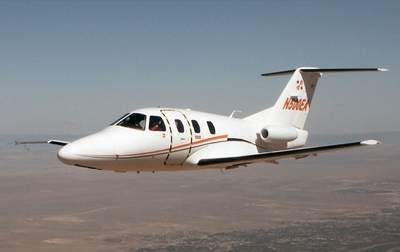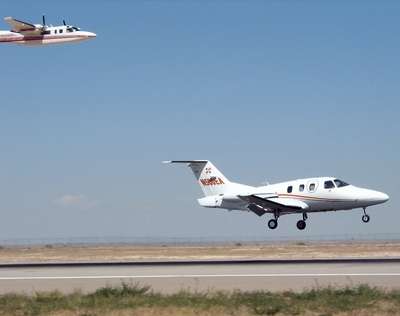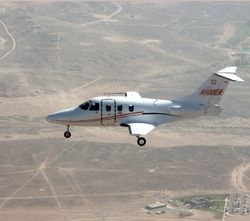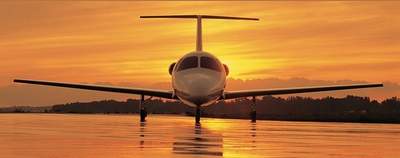Advanced Telemetry System Mines Rich Data from Revolutionary
Jet's First Full Week of Flight
 Just seven days after announcing the resumption of
Eclipse 500 flight testing, Eclipse Aviation today reported results
of the breakthrough jet's first full week of flight. The Eclipse
500 has completed six test flights, logging five hours in the air
at speeds from 85 knots to 183 knots and altitudes up to 15,000
feet. The aircraft's advanced L-band telemetry system, which yields
significantly more data per flight than traditional systems, has
provided a wealth of information on the jet's performance in these
flights. Please note who's playing chase pilot on a number of the
test flights... it seems that being the CEO DOES have it's
perqs...
Just seven days after announcing the resumption of
Eclipse 500 flight testing, Eclipse Aviation today reported results
of the breakthrough jet's first full week of flight. The Eclipse
500 has completed six test flights, logging five hours in the air
at speeds from 85 knots to 183 knots and altitudes up to 15,000
feet. The aircraft's advanced L-band telemetry system, which yields
significantly more data per flight than traditional systems, has
provided a wealth of information on the jet's performance in these
flights. Please note who's playing chase pilot on a number of the
test flights... it seems that being the CEO DOES have it's
perqs...

"The fact that we have accomplished so much in flight test in
such a short time is a tribute to the maturity of the aircraft
design. And now, with a handful of test flights, the advanced data
acquisition system on aircraft 100 has allowed us to learn more
about the aerodynamic characteristics and systems operations of
this jet in one week than we would be able to discover over many
months using traditional limited telemetry systems and flight test
procedures," said Vern Raburn, president and CEO of Eclipse
Aviation. "Our engineers are able to see what is happening to the
airplane in real time. The results are very positive and prove that
the Eclipse 500 airframe program is on track despite earlier engine
vendor problems."
Flight Test Milestones
Following its initial flight on August 26, 2002, the Eclipse 500
jet resumed testing on May 15, 2003 and in one week completed the
initial phase of flight test. The first phase focused on low-speed
handling characteristics and systems operations. Aircraft 100 was
examined in highly turbulent conditions and the landing gear was
cycled throughout the speed range, including emergency extensions.
Flap operations were tested to within 15 knots of their final
operating envelope and the airplane was also accelerated to 2.5 g's
in turning flight.

During these flights, the fuel system was operated and examined
while using both fuel transfer as well as emergency fuel pump
operation. Throughout the flights, the AvioTM intelligent flight
system was operational with all essential features working,
including system synoptic pages. All of the electrical functions
have utilized the electronic circuit-breakers, which are
representative of the production system.
Data Acquisition System Expands Traditional Testing
Parameters
 The Eclipse 500 flight test instrumentation system
is capable of recording and displaying instrumentation parameters
to the pilot and to engineers on the ground in real time. At this
point, more than 500 parameters are recorded and available for
display to the pilot and to engineers on the ground in real time,
which is five to ten times more than those available to the typical
general aviation manufacturer. The telemetry system has been
operational throughout the testing. This has enabled Eclipse's
specialists to watch over every aspect of the systems, structures,
aircraft handling and performance.
The Eclipse 500 flight test instrumentation system
is capable of recording and displaying instrumentation parameters
to the pilot and to engineers on the ground in real time. At this
point, more than 500 parameters are recorded and available for
display to the pilot and to engineers on the ground in real time,
which is five to ten times more than those available to the typical
general aviation manufacturer. The telemetry system has been
operational throughout the testing. This has enabled Eclipse's
specialists to watch over every aspect of the systems, structures,
aircraft handling and performance.

Interim Engines Advance Flight Test Program
To enable Eclipse Aviation to advance the flight test program
prior to receiving the Pratt & Whitney Canada PW610F engines
that will be used on the production aircraft, the Eclipse 500 test
aircraft has been equipped with an interim engine made by Teledyne,
model 382-10E. After completing the development testing of the
Eclipse 500 aerodynamics and systems with the interim engines,
subsequent flight test aircraft will be used for certification
flight testing with the Pratt & Whitney Canada engines, which
will be available in late 2004. Altogether there are eight test
aircraft, six of which will fly and two of which will be used for
structural testing.
Eclipse 500 Flight Testing Overview
 High-speed taxi
High-speed taxi
May 12th and May 14th
Pilot: Bob Suter
The objective of these tests was to examine the operation of the
Teledyne experimental engines at flight speeds, verify the
performance of the Data Acquisition and Telemetry systems and
familiarize the pilot with the aircraft. Both tests included a
single run down the runway, accelerating to 75 and 95 knots
respectively as well as lift off and flight to about 6 feet from
the ground on the first flight for 2,500 feet on the second run.
All systems and handling characteristics behaved as expected.
Flight 002 - (Flight 001 was on August 26, 2002)
May 15th, 8:47 a.m. take off
Pilot: Bob Suter, Chase Pilot: Vern Raburn
Flight duration: 26 minutes
The test cards called for initial handling examination at 10,000
feet. However, due to very bumpy weather and wind speeds that were
rapidly increasing, the actual flight time was shortened. At
landing, the wind speed was 30 knots with gusts up to 44 knots. The
pilot reported that the aircraft behaved exceptionally well in
these gusty conditions. Telemetry and data acquisition worked
perfectly with ten engineers from specialist groups watching over
every element of the flight on their dedicated computer
screens.
Flight 003
May 16th, 9:07 a.m. take-off
Pilot: Bill Bubb, Chase Pilot: Bob Suter
Flight duration: 78 minutes
The landing gear was retracted and extended a total of eight cycles
at varying speeds up to 140 knots, including two successful
attempts at emergency extension at the same speeds. The gear
operated flawlessly throughout. The aircraft accelerated to 175
knots with the gear up at only a very low-thrust setting on the
engine (about 350 lbs thrust per engine) even though no gear doors
are fitted. Handling characteristics checks showed no problems and
speed brake actuation was examined up to 140 knots with no
problem.
Flight 004
 May 16th, 4:25 p.m. take-off
May 16th, 4:25 p.m. take-off
Pilot: Bill Bubb, Chase Pilot: Bob Suter
Flight duration: 52 minutes
The objective of this flight was to take the aircraft to a 2.5 g
wind up turn and to check sideslip loading conditions. The aircraft
behaved as expected. The ailerons worked without problem during the
high g maneuver and the stick forces were acceptable in both pitch
and roll.
Flight 005
May 20th, 9:32 a.m. take-off
Pilot: Bill Bubb, Chase pilot: Vern Raburn
Flight duration: 53 minutes
The goal of this flight was to obtain full clearance of the flap
deployment envelope. Tests were conducted at between 13,000 feet
and 15,000 feet at speed increases in steps up to 183 knots at
take-off flap setting and 140 knots for full flap. The flaps
operated just as expected. The flaps provided excellent drag and
lift increases. Until stall testing begins, a safety margin is
applied to the minimum speeds, so the lowest speed examined during
this flight was 86 knots, where the controllability of the aircraft
was excellent. The speed brake extension was examined up to 160
knots, again with no appreciable pitch change or vibration.

Flight 006
May 20th, 3:51 p.m. take-off
Pilot: Bill Bubb, Chase pilot: Vern Raburn
Flight duration: 25 minutes
The flight commenced with a photo session over the Eclipse factory.
The Eclipse 500 was then on its way, with the test pilot examining
structural aircraft response to control inputs up to 200 knots. The
flight was concluded early due to high turbulence and a minor
problem with the data acquisition system.
 ANN's Daily Aero-Linx (04.15.24)
ANN's Daily Aero-Linx (04.15.24) Classic Aero-TV: 'No Other Options' -- The Israeli Air Force's Danny Shapira
Classic Aero-TV: 'No Other Options' -- The Israeli Air Force's Danny Shapira Aero-News: Quote of the Day (04.15.24)
Aero-News: Quote of the Day (04.15.24) Airborne 04.16.24: RV Update, Affordable Flying Expo, Diamond Lil
Airborne 04.16.24: RV Update, Affordable Flying Expo, Diamond Lil ANN's Daily Aero-Term (04.16.24): Chart Supplement US
ANN's Daily Aero-Term (04.16.24): Chart Supplement US









